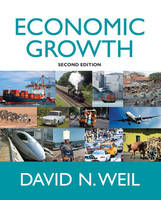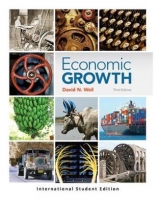
Economic Growth
Routledge (Verlag)
978-0-321-41662-9 (ISBN)
- Titel erscheint in neuer Auflage
- Artikel merken
With its comprehensive and flexible organization, Economic Growth is ideal for a wide array of courses, including undergraduate and graduate courses in economic growth, economic development, macro theory, applied econometrics, and development studies.
Preview online! An interactive tour of Economic Growth is available here.
David Weil is a professor of economics at Brown University. He received his BA in history from Brown University and his PhD in economics from Harvard University. A former member of the Board of Editors at the American Economic Review, Professor Brown is a research associate at the National Bureau of Economic Research (NBER) and associate editor of the Journal of Economic Growth.
Part I. Overview
Chapter 1. The Facts to Be Explained
Differences in the Level of Income Among Countries
Differences in the Rate of Income Growth Among Countries
Appendix: Measuring and Comparing GDP Using Purchasing Power Parity Problems
Chapter 2. A Framework for Analysis
The Economics of Sylvania and Freedonia: A Parable
From Parable to Practice
What Can We Learn from Data?
Part II. Factor Accumulation
Chapter 3. Physical Capital
The Nature of Capital
Capital’s Role in Production
The Solow Model
The Relationship Between Investment and Saving
Appendix: Further Exploration of the Cobb-Douglas Production Function and the Speed of Convergence in the Solow Model
Chapter 4. Population and Economic Growth
Population and Output over the Long Run
Population Growth in the Solow Model
Explaining Population Growth
Explaining the Fertility Transition
Appendix: A More Formal Description of the Total Fertility Rate, Life Expectancy, and Net Rate of Reproduction
Chapter 5. Future Population Trends
Forecasting Population
The Economic Consequences of Demographic Change
Chapter 6. Human Capital
Human Capital in the Form of Health
Human Capital in the Form of Education
How Much of the Variation in Income Across Countries Does Education Explain?
Part III. Productivity
Chapter 7. Measuring Productivity
Productivity in the Production Function
Differences in the Level of Productivity Among Countries
Differences in the Growth Rate of Productivity Among Countries
Chapter 8. The Role of Technology in Growth
The Nature of Technological Progress
Modeling the Relationship Between Technology Creation and Growth
Barriers to International Technology Transfer
Mathematical Appendix:
Incorporating Technological Progress into the Solow Model
Steady State
The Effect of a Change in Technology Growth
Chapter 9. The Cutting Edge of Technology
The Pace of Technological Change
The Technology Production Function
Differential Technological Progress
Mathematical Appendix: An Improved Version of the Technology Production Function
Chapter 10. Efficiency
Decomposing Productivity into Technology and Efficiency
Differences in Efficiency: Case Studies
Types of Inefficiency
Mathematical Appendix: Sectoral Reallocation and the Growth Rate of Aggregate Productivity
Chapter 11. Growth in the Open Economy
Autarky Versus Openness
The Effect of Openness on Economic Growth
Openness and Factor Accumulation
Openness and Productivity
Opposition to Openness
Part IV. Fundamentals
Chapter 12. Government
Defining Government’s Proper Role in the Economy
How Government Affects Growth
Why Governments Do Things That Are Bad for Growth
Why Poor Countries Have Bad Governments
Chapter 13. Income Inequality
Income Inequality: The Facts
Sources of Income Inequality
Effect of Income Inequality on Economic Growth
Beyond Income Distribution: Economic Mobility
Chapter 14. Culture
The Effect of Culture on Economic Growth
What Determines Culture?
Cultural Change
Chapter 15. Geography, Climate, and Natural Resources
Geography
Climate
Natural Resources
Chapter 16. Resources and the Environment at the Global Level
Natural Resource Concepts
Incorporating Natural Resources into the Analysis of Economic Growth
Growth and the Environment
Mathematical Appendix: Technological Improvement Versus Resource Depletion
Part V. Conclusion
Chapter 17. What We Have Learned and Where We Are Headed
What We Have Learned
What the Future Holds
A Final Thought
| Erscheint lt. Verlag | 13.3.2008 |
|---|---|
| Verlagsort | New York |
| Sprache | englisch |
| Maße | 187 x 232 mm |
| Gewicht | 953 g |
| Themenwelt | Wirtschaft ► Volkswirtschaftslehre |
| ISBN-10 | 0-321-41662-7 / 0321416627 |
| ISBN-13 | 978-0-321-41662-9 / 9780321416629 |
| Zustand | Neuware |
| Haben Sie eine Frage zum Produkt? |
aus dem Bereich



